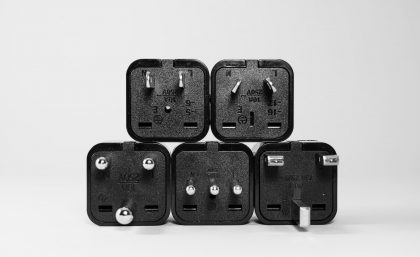In mid-November, I had the pleasure of representing Archilizer at Autodesk University in Las Vegas. The scale of the conference was more than overwhelming at first – just putting together my schedule of classes was intimidating, but once I dove into it, I found there was a sophisticated system of support.
Autodesk University 2018 in Las Vegas had about 11 000 attendees, that could benefit from a full programme of classes for the 4 main days of the conference, and additional Computational Monday classes, and various networking events every evening. Keeping all this in mind this is my – one single human – review of what went down in Vegas – it was too good folks, can’t let it stay there!
My AU2018 review comes to you in three parts. In this part one, I want to share my personal experiences and impressions. Part two will give you my three class recommendations to go and look into recordings and/or materials from. And finally, because you will be itching to go next year by the time you have gotten there, part three will give you my tips for AU2019.
The most nerve-racking thing, of course, was giving my talk – I had the enormous pleasure to speak at the Computational Forum at AU, where we had six speaker slots, 4 of which were entirely taken by women, one was a collection of speakers that also featured a woman, and only one slot was entirely dedicated to a male speaker. This was a first for me, and I was very excited to be a part of this. The entire conference did not feel exactly like this, however, and we are not at all “at the please where we don’t need “Women in …” groups”, however it was great to see that an effort was definitely made to show diversity on the promotional materials and presentations.
Fortunately, the Computational Forum was on the Monday afternoon, and I really got to appreciate that during the full day of classes prior to the Computational Forum where I spoke. I was very happy not to be that distracted for the rest of the conference. The day started with a General Computational Session, opened by Racel Williams, whose energy is always beautifully contagious, and closed off by Michael Krischner, who gave us some valuable general programming theory. Following this, I was in a developer workshop lead by Radu Gidei, whose name may make you feel like you were greeted by an Australian, but is, in fact, someone I know well from the UK Dynamo User Group. Even though I was quite nervous most of the day, he managed to present a class that even my distracted mind could comfortably understand. Radu has been working in using Dynamo to interface with platforms outside of Revit for a while now, and his insight and guidance in the world of actual real-life programming was priceless (because you know “if it’s a bunch of text on a black background it must be programming”).
The day of computation finished with a line of speakers, by whom I feel endlessly privileged to be standing. You can see the full recording, including my input on Everyday use of Dynamo (starts at 08:00) Here.

Lilly Smith hosted the forum, opening with an intro for where Dynamo is at the moment – with 1.3m downloads from the Dynamo package Manager – we can say – a good place. She also closed the evening off talking about the current projects of the AEC generative design group at Autodesk. I took it over from her and spoke about my experience getting into automation, and how easy it is to start saving time with simple data graphs. Then Shwanee Finlayson spoke about the future of automation and generative design and the importance of quality data – it was really interesting to hear about the issues she came across on the route to preparing for machine learning with Dynamo. Efrie Escott then told us about the research she has had the opportunity to do within her office gathering data and learning how to evaluate the quality of the data – something I find so important to consider – how do you make quality data off of a self-assessment comfort survey – is this even possible – well she makes it possible! We also heard from all of the instructors from the day of computational classes headed by Racell Williams – each class was more exciting than the previous one! The last story came from Luke Church who spoke to us about the issues with machine learning, which was very interesting to hear, he suggested that a way to progress beyond the current hurdles is to implement doubt in machine learning, which I have to say I love as an idea. He also spoke to us about his work implementing machine learning in the facilitation of social dialogue with Africa’s Voices Foundation – a really brilliant spin outside the AEC industry and a truly inspirational talk.

A resounding message from the computational forum that was echoed throughout the entire conference was that the problem with data in the AEC industry is the lack of clean data. The AEC industry is predominantly visual and even though that sounds natural, it is not helpful to BIM or any other smart workflows. Something I consider one of my main priorities is to entice architectural professionals to start considering and really working with non-graphic information more.
But a picture is worth a thousand words, I hear you say. Yes, that is entirely true, however, a picture is worth a thousand, messy, inconsistent, tangled words in all of the languages imaginable. It takes some serious muscle to turn those thousand words in a thousand lines of valuable data. Because a thousand lines of valuable data – well that is worth actual something, from personal experience – refer to the end of my talk – I can tell you that 3,500 lines of valuable data, can be worth 9 working days, and because I love maths, I’ve done the numbers for you –
efficiency for words per day is 3500/9,
then 3500/9=1000/x,
so x=1000*9/3500,
x=2.571 days for 1 untangled picture
I can’t say I have any data to prove a thousand jumbled up words are worth something – if anything, they cost a lot of time to unjumble.
The opening keynote on Tuesday delivered by Andrew Anagnost was a very colourful performance. Indeed the hall and the whole set up made me feel more like at a rave, rather than technology conference, and I must admit, I did not mind that one little bit. Xxx told a narrative that may be expected, promotional and very positive towards Autodesk products and initiatives, and I can be as cynical about it as anyone, but I’d like to jump over the “well, of course, the Autodesk CEO will say that” and the “it’s all a promo for their products” kind of statements and actually take in what was given with a positive spin. “The Opportunity of Better” in letters taller than me graced us from several aggressively sized screens multiple times. And I do believe what those stand for. I have been very alarmed to hear here in the UK about the “fear” and “danger” of technology, and as someone who has the first-hand experience my job becoming better and more exciting because of technology, I don’t feel great about sewing the seeds of that kind of attitude around. Technology being compared to Brexit with its negative impact on our industry, has been something that has been making me very concerned for a while, and while the blind fearmongering is just as bad as the blind positivism, I did need some fuel for my own crusade to prove that automation and technological advancement can be positive, and this is exactly what Andrew was selling – technology making jobs BETTER. As anything non-human, technology really can’t be “Good” or “Bad” – it just is, and the way that we use it – ie the human input colours the result positive or negative. The way that we use it is very much governed by the attitude with which each and every one of us approaches it, so we need to create a positive productive attitude, rather than quoting large theoretical numbers of lost jobs due to automation.

An integral part of the conference and arguably as important as the classes was the networking aspect. I was so excited and inspired by the people I spoke to and met there. The BIM community as a whole in the UK has never disappointed with its openness and welcoming spirit, and I was a delight to witness the same on an international level. Autodesk had gone to admirable lengths to facilitate dialogue between themselves and the attendees of the conference – there were high-level management staff available for chats, idea boards and a video booth to record messages if you feel a bit shy. But all the attendees and speakers were also truly approachable. I did have several moments of “OMG, I want to be friends and work with you please” and felt no barrier to expressing those feelings – I’m looking at you *insert 20 names here*. One very meaningful interaction for me was our little BIM Manager Bootcamp gathering with the legend that is Michael Kilkelly and some of my fellow campers. (Look out for my review of Archsmarter’s BIM Manager Bootcamp in January) Getting a chance to meet my international coursemates was really great – online learning has always been very helpful to me as an audio-learner, however, there is an amplification of confidence and motivation that can only be achieved when spending time with people live. Another BIM celebrity sighting – the brilliant John Pierson was so generous to give me some advice on small BIM business development (“keep at it, not all the work is going to be super exciting, but the good things will come in-between setting up project templates for small businesses”)
As a BIM professional, AU is definitely an experience one wants to have at least once in their lifetime. The quality of the classes, the entire set up and services available were all of brilliant quality, but instead of going in detail about any of this I would like to leave you with this thought – there were DOGS – there were therapy dogs available in the AU2018 hub. If you had had too much of technology and learning, you were able to go to a white picket fence enclosure and cuddle a puppy. Because there is nothing healthier than seeing someone who has kept their cool in front of a huge international professional audience for an hour talking about super complicated things, collapse on their knees and go “ah, who’s a good gal, yes you’re a good gal, you are the GOODEST gal”. In today’s polarised and tensed-up world, this is what we need – balance. Good job Autodesk.





Leave a Reply
Want to join the discussion?
Feel free to contribute!